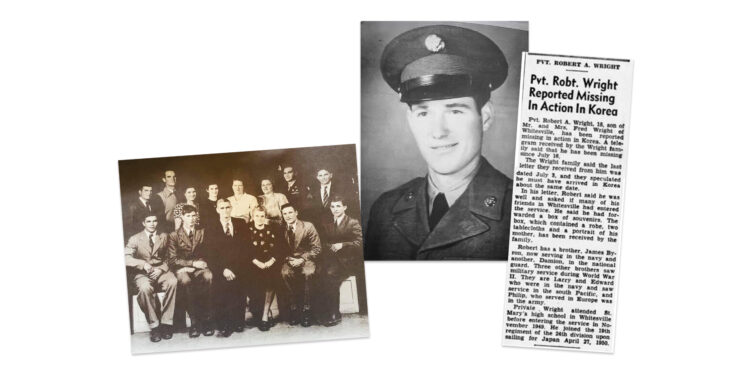When Robert Wright was 17 years old, he asked his mother to sign paperwork that would allow him to join the Army while he was still under the age of 18. With five older brothers, each serving in various branches of the military, Wright aspired to be as brave as them. His mother agreed and Wright left St. Mary’s High School in Whitesville to depart for boot camp in November 1949. Private First Class (PFC) Wright joined Company C, 1st Battalion, 19th Infantry Regiment, 24th Infantry Division and set sail for Japan in April 1950. Wright was declared missing in action (MIA) in Korea on July 16, 1950 and declared dead in December 1953.
On Aug. 15, 2022, 72 years after being declared missing, Wright’s remains were located and identified. His remaining family members were notified that PFC Wright would finally be returning home.
One of the family members notified by the Department of Defense (DOD) was Wright’s niece, former Veterans of Foreign Wars (VFW) Women’s Auxiliary president, Jessie Hettinger.
“They have not told us where they found him,” Hettinger said. “They just told us they have skeletal remains and that his body was very deteriorated. They said his bones were so brittle they had to use DNA from his tooth.”
Hettinger said that several years ago, when Wright’s sisters were still living, the government reached out to each family with a missing service member to request a DNA sample for the purpose of future identification.
“Thank God they got in touch with them (his sisters) before they passed away or we wouldn’t have him back,” Hettinger said. “They have a lot of bodies in Hawaii they haven’t been able to identify because they did not have matching DNA samples.”
Hettinger is referring to Oahu, Hawaii, where the U.S. Department of Defense POW/MIA Accounting Agency has established the largest forensic anthropological skeletal lab in the world. Using updated forensic techniques, as well as DNA sampling, dental testing, and collar bone matching, the DOD has made significant progress in identifying some of the estimated 81,000 soldiers reported missing from the WWII through Gulf War eras, including PFC Wright.
Although Hettinger was only four when her uncle left for the Army, she still has positive memories of him, mostly from shared family stories.
“Granny (his mother) never talked much about Uncle Bobby. When she was in her older age, she would tell us stories about him,” Hettinger said. “A lot of people told me he babysat me and my sister, and that he loved horses. It made me get to know him better.”
Despite her young age during her uncle’s service and passing, Hettinger has become an advocate for local veterans, as well as those soldiers that remain MIA.
After her Army veteran husband, Roland Hettinger, died in 2006, Jessie became a member of the VFW and worked her way to Women’s Auxiliary president by 2014. Through her work with the auxiliary, Hettinger participated in several commemorative events. She vividly remembers attending a Rolling Thunder ceremony that would forever change her life and the way she remembered her uncle.
“I saw the Rolling Thunder missing man table,” Hettinger said, referring to the military dinner table set as a solemn reminder of the missing or fallen “comrades” that cannot attend. “I realized I needed to get Uncle Bobby’s name out there.”
Hettinger began working more actively with Rolling Thunder in an effort to support their mission of educating the public about POW and MIA service members.
“When we did the dedication in Knottsville, Al Mattingly mentioned Uncle Bobby’s name and him being missing,” Hettinger said. “A lot of people didn’t know he was an MIA and that he was still missing.”
From that point forward, while she continued her work assisting local veterans with applying for benefits, Hettinger remained dedicated to keeping her uncle’s memory alive, at dedications, military events, and through personalized T-shirts for family members.
Currently, there is a remembrance marker at St. Mary of the Woods Cemetery in Whitesville, Kentucky dedicated to PFC Wright. Later this year, the family hopes that the marker will be replaced with a final marker, and Wright’s remains will be cremated and placed at the foot of his mother’s grave.
Hettinger and her cousins hope to hear from the DOD later this month to learn more about where her uncle was found and to make final arrangements for his burial.
“When they have the meeting with us, they are supposed to tell us where they found him — truthfully we will never know what happened to him,” Hettinger said. “I’m just glad I’m still alive when they found him to bring him home.” OL










